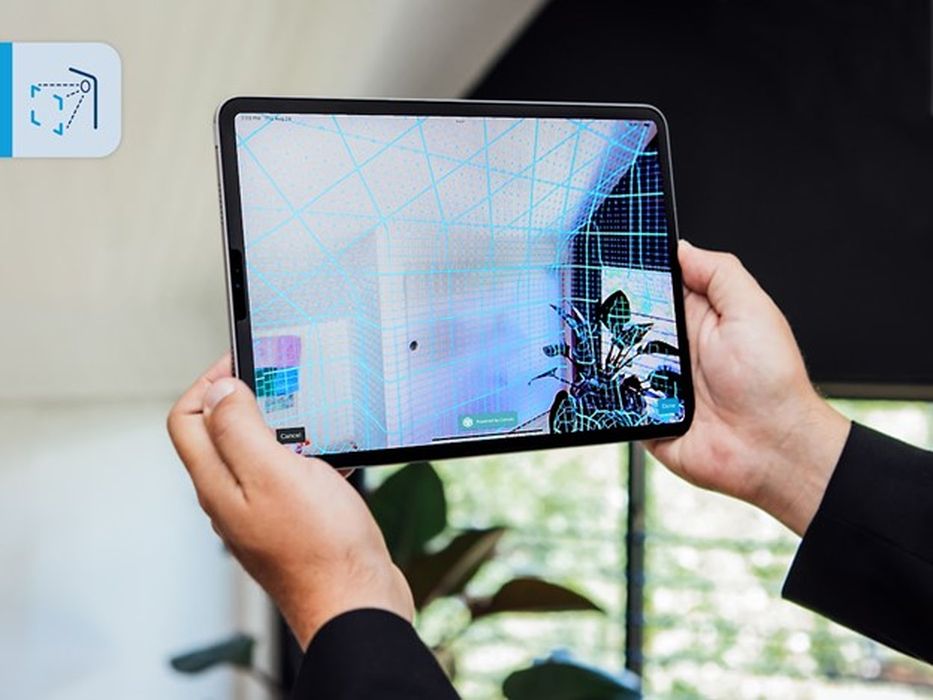
Trimble implements Canvas.io technology to create SketchUp models.
SketchUp is the first CAD program to directly use the LiDAR from consumer devices. Trimble, the company that owns SketchUp, announced that it will use the built-in LiDAR on Apple’s giant iPads (iPad Pro) to create a SketchUp model from a scan. You may not have an iPad Pro, but after reading about how fast and easy it is to make 3D models of buildings and interiors, you may very well want one.
Suppose you are a general contractor, interior designer, floorer, real estate agent, broker or DIYer… let’s say anyone who needs a floor plan or a 3D model, anyone who has had to use a tape measure to lay out an as-built, a homeowner who needs a floor plan for a permit and doesn’t want to hire an architect… All those that have had to spend hours taking measurements can all now pretty much wave an iPad at the walls and voila! Up pops a 3D SketchUp model. Modeling of existing spaces and as-builts has never been easier.
Accuracy or speed? Pick one
Okay, it’s not quite as quick as implied. It takes a few minutes to paint the walls, as it were, with the invisible LiDAR beam of the iPad. It takes a few more minutes to process the LiDAR data (Trimble does that on the cloud). You have to have a few things in place, like a license for SketchUp.
And, of course, you must have a recent model iPad Pro, at least a 5th generation. They’re the most expensive tablets you can buy. The most recent and most significant, the 13″ model iPad Pro 6th generation, was recently introduced with a starting price of $1299. Then there are models with extra RAM models, the Pencil, the keyboard, insurance… and the cost can climb to over $3K.
Clearly, the iPad Pro can’t be a toy; it must be a tool. Then, think of it not as a very expensive tape measure but a very reasonably priced scanner. Trimble’s professional quality laser scanners, for which it is famous, can be 10 to 20 times as much.Think of it as CAD operator, but one you buy and keep. Much to your delight, you will find that it can do 2D _and_3D, unlike most CAD operators, for whom 2D is their only space.
We have looked at several apps that use Apple devices, including Polycom(our current favorite for its interface and one-price-all-you-can-eat-for-one price: $99.99/year), CamToPlan,& Canvas (used by SketchUp), and Magicplan. All these applications are most impressive for their ability to recognize walls, ceilings, windows, and doors using Apple’s built-in RoomPlan & framework and its LiDAR hardware. Canvas.io and SketchUp ups the ante, acting in concert to tag objects.
Scan-to-Design, as this feature is called in SketchUp, is smart enough to recognize and tag furniture, such as tables, chairs, and sofas, storage (closets), appliances like refrigerators, stoves, washers and dryers, dishwashers, TVs, sinks, toilets, and bathtubs. These are stored as blocks and can be moved, replaced, etc., as single objects.
All the LiDAR apps for Apple devices work by pressing a record button which immediately lets the app gather the walls and other features in an interior space. The best of them (Polycam) let you see the 3D model as you scan, detecting edges and corners for walls, furniture, visually verify your LiDAR coverage with an inset image of a 3D model. It’s magical and fun.
Others, such as Canvas and SketchUp implementation of it, cover the scanned surfaces with a 3D mesh or attempt a fully rendered 3D model. The 3D mesh and the rendered 3D model will easily confirm areas that have been scanned so you don’t miss a spot. Still, the mesh and rendered model move around, quivering like Jello, seemingly constantly updating, which is a little distracting compared to the neater, more precise-looking, more stable 3D model Polycam uses.
Still, both are a welcome alternative to a tape-measure and sketch approach in widespread practice today. At the end of your scan, you may finally use a tape measure (or laser measure) to check one or two dimensions to confirm the miracle: you have captured all the details of a space without a single measurement until it was all over.
In all fairness, you will find your tape measure to be more accurate than the Apple LiDAR models, which can be off 1 to 2%, according to Canvas.io. Over a 50 ft length, that can be a whole foot. Don’t stop reading. The apparent advantage of accuracy over tape or laser measure is at least partially offset by building inaccuracy. Walls are rarely completely square to each other. A wall-to-wall measurement on one side of the room could be different than on the other side. A single measurement, even with a laser measurement, could give you a false sense of accuracy.
A scan, however, will accurately capture the out-of-square in the as-built with millions of measurements. But most importantly, even with drift error from room to room, whatever you have lost in accuracy, you have gained in time. It can take hours to measure up each floor and make a CAD drawing, something you have accomplished in minutes by scanning.
For trades in which utmost accuracy is required, such as flooring, which may need to cut to the 16th of an inch, it would be wise to use tape or laser measurement.
Read the rest of this story at ENGINEERING.com
